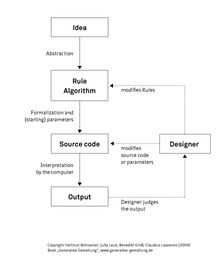Generative design
Generative design is an iterative design process that involves a program that will generate a certain number of outputs that meet certain constraints, and a designer that will fine tune the feasible region by changing minimal and maximal values of an interval in which a variable of the program meets the set of constraints, in order to reduce or augment the number of outputs to choose from. The program doesn't need to be run on a machine like a digital computer, it can be run by a human for example with pen and paper. The designer doesn't need to be a human, it can be a test program in a testing environment or an artificial intelligence, for example a generative adversarial network. The designer learns to refine the program (usually involving algorithms) with each iteration as their design goals become better defined over time.[1]

The output could be images, sounds, architectural models, animation, and much more. It is therefore a fast method of exploring design possibilities that is used in various design fields such as art, architecture, communication design, and product design.[2]
The process combined with the power of digital computers that can explore a very large number of possible permutations of a solution enables designers to generate and test brand new options, beyond what a human alone could accomplish, to arrive at a most effective and optimized design. It mimics nature’s evolutionary approach to design through genetic variation and selection.
Generative design is becoming more important, largely due to new programming environments or scripting capabilities that have made it relatively easy, even for designers with little programming experience, to implement their ideas.[3] Additionally, this process can create solutions to substantially complex problems that would otherwise be resource-exhaustive with an alternative approach making it a more attractive option for problems with a large or unknown solution set.[4] It is also facilitated with tools in commercially available CAD packages. Not only are implementation tools becoming more accessible but also tools leveraging generative design as a foundation.[5]
See also
References
- Meintjes, Keith. ""Generative Design" – What's That? - CIMdata". Retrieved 2018-06-15.
- ENGINEERING.com. "Generative Design: The Road to Production". www.engineering.com. Retrieved 2019-12-05.
- Schwab, Katharine (16 April 2019). "This is the first commercial chair made using generative design". Fast Company. Retrieved 13 August 2019.
- Prasanta, Rajamoney, Shankar A. Rosenbloom, Paul S.; Wagner, Chris Bose (2014-09-04). Compositional model-based design: A generative approach to the conceptual design of physical systems. University of Southern California. OCLC 1003551283.
- Anderson, Fraser; Grossman, Tovi; Fitzmaurice, George (2017-10-20). Trigger-Action-Circuits: Leveraging Generative Design to Enable Novices to Design and Build Circuitry. ACM. pp. 331–342. doi:10.1145/3126594.3126637. ISBN 9781450349819.
Further reading
- Gary William Flake: The Computational Beauty of Nature: Computer Explorations of Fractals, Chaos, Complex Systems, and Adaptation. MIT Press 1998, ISBN 978-0-262-56127-3
- John Maeda: Design by Numbers, MIT Press 2001, ISBN 978-0-262-63244-7
- Krish, Sivam (2011). "A practical generative design method". Computer-Aided Design. 43: 88–100. doi:10.1016/j.cad.2010.09.009.
- Celestino Soddu: papers on Generative Design (1991-2011) at http://www.generativedesign.com/papers.html